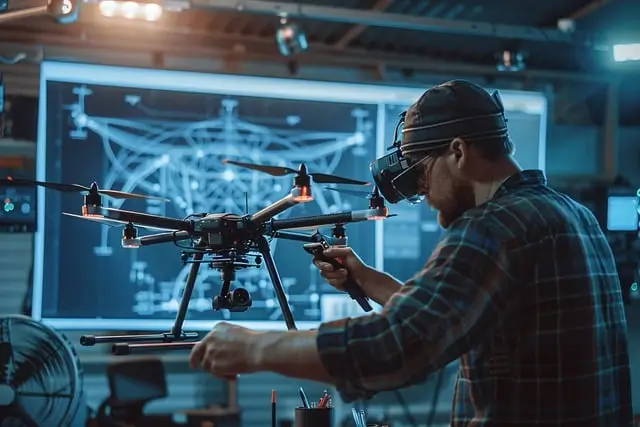Drone Threat Over US Cities
The Drone Scare Across the Country: What We Know and How to Address It
Drone Threat Over US Cities. The recent surge in drone-related incidents across the United States has raised alarm bells among citizens and policymakers alike. From mysterious swarms over critical infrastructure to potential threats from foreign adversaries, the drone scare has become a national conversation. In this post, we’ll break down what we know so far, explore prevailing theories, assess the dangers, and propose common-sense measures to address the issue.
Table of Contents
What We Know So Far
Over the past year, there have been numerous reports of unidentified drones flying over sensitive areas, including power plants, military installations, and urban centers. These incidents have sparked widespread concern due to their implications for public safety, national security, and privacy. Here are some key points:
- Incidents in Critical Areas: Drones have been spotted near nuclear power plants, airports, and military bases. In many cases, their operators remain unidentified, leaving law enforcement and federal agencies scrambling for answers.
- Increase in Drone Sightings: According to reports from the Federal Aviation Administration (FAA), drone-related incidents have nearly doubled over the past two years. This includes both unauthorized flights and sightings of unidentified aerial objects.
- Government Response: Federal agencies, including the Department of Defense (DOD), Department of Homeland Security (DHS), and the FAA, are actively investigating these incidents. Measures such as drone detection systems and restricted airspace have been deployed in high-risk areas.
- Commercial and Hobbyist Drones: While many incidents involve unidentified drones, a significant portion of drone activity can be attributed to commercial operators and hobbyists. However, distinguishing between harmless and malicious intent remains a challenge.
Theories About the Drone Scare
The mystery surrounding these incidents has given rise to several theories. While no single explanation covers all cases, these are the most commonly discussed possibilities:
- Foreign Adversaries: One of the most concerning theories is that some of these drones are operated by foreign actors, such as China or Russia, to gather intelligence or test U.S. response systems. This aligns with broader concerns about espionage and cyber warfare.
- Corporate Espionage: Another theory suggests that certain drones may be used for industrial espionage, targeting proprietary technologies or sensitive data from corporations and government facilities.
- Malicious Individuals or Groups: Some incidents could be the work of domestic individuals or groups with malicious intent, such as attempting to disrupt critical infrastructure or conduct surveillance.
- Technological Glitches or Misuse: A less sinister but plausible explanation is that some sightings result from lost or malfunctioning drones operated by hobbyists or commercial entities. The lack of robust regulations and tracking systems exacerbates this issue.
- Unintentional Hysteria: Finally, it is worth considering that some of the reports may stem from misidentifications or heightened public awareness, leading to false alarms.
Potential Dangers and Risks
The proliferation of drones—both identified and unidentified—poses several dangers. These risks span multiple domains, from personal safety to national security:
- National Security Risks: Unidentified drones near military installations and critical infrastructure could indicate reconnaissance or preparatory activity by adversaries. These incidents underscore the vulnerability of key facilities to aerial threats.
- Aviation Safety: Unauthorized drones flying near airports pose a severe risk to commercial aviation. Collisions between drones and aircraft could lead to catastrophic outcomes.
- Privacy Concerns: The ability of drones to conduct surveillance has raised significant privacy concerns among citizens, particularly in urban areas.
- Potential for Weaponization: The possibility of drones being equipped with explosives, dirty nukes, biological or other weapons presents a direct threat to public safety.
- Economic Disruption: Disruptions caused by drone activity can have economic implications, such as delayed flights, increased security costs, and potential damage to infrastructure.
How to Address the Drone Scare: Common-Sense Measures
Given the complexity and multifaceted nature of the issue, a balanced approach is necessary. Here are some common-sense measures that can help mitigate the risks:
- Strengthening Drone Regulations:
- The FAA should update and enforce stricter regulations for drone operations, including mandatory registration, geofencing, and flight logging.
- Require manufacturers to include “no-fly zone” programming to prevent drones from entering restricted areas.
- Enhancing Detection and Response Capabilities:
- Deploy advanced drone detection and counter-drone systems at critical infrastructure sites and airports.
- Train law enforcement and security personnel to identify and respond to unauthorized drone activity effectively.
- Public Awareness Campaigns:
- Educate hobbyists and commercial drone operators about existing regulations and safe operation practices.
- Encourage citizens to report suspicious drone activity while avoiding unnecessary panic.
- Improved Interagency Coordination:
- Foster better communication and coordination among federal, state, and local agencies to streamline the investigation of drone incidents.
- Develop a centralized database for tracking and analyzing drone sightings and incidents.
- Research and Development:
- Invest in the development of technologies to identify and neutralize rogue drones without causing collateral damage.
- Collaborate with private companies and research institutions to stay ahead of emerging drone technologies.
- International Cooperation:
- Work with international partners to address the global nature of drone threats, particularly concerning espionage and cross-border activity.
- Establish norms and agreements for the responsible use of drones.
- Penalties for Misuse:
- Increase penalties for individuals and organizations that operate drones in violation of regulations, particularly in sensitive areas.
- Implement measures to trace drones back to their operators, deterring malicious activity.
Drone Threat Over US Cities
Conclusion
The democrat party is in charge and has a long history of failing to do what’s right. They’re weak on law and order and national security and has continually put America in danger by be the party of no action. The Democratic Party’s leadership has faced criticism for perceived failures in protecting America from threats such as Chinese spy balloons, drones, and potential terrorists crossing the southern border.
Critics argue that their response to these incidents has been slow or insufficient, highlighting lapses in border security and national defense measures. For instance, the delayed action on Chinese surveillance balloons raised concerns about the administration’s ability to swiftly address espionage threats. Similarly, growing fears over drug cartels and possible terrorist infiltration at the U.S.-Mexico border have intensified debates over the effectiveness of border policies under Democratic leadership. These issues have fueled claims that the current administration’s approach to national security lacks urgency and fails to prioritize Americans’ safety.
The drone scare is a wake-up call for the U.S. to address vulnerabilities in its airspace and critical infrastructure. While the root causes of many incidents remain unclear, the risks are too significant to ignore. By implementing common-sense measures, from enhanced regulations to public education, we can strike a balance between embracing the benefits of drone technology and mitigating its potential dangers. As we navigate this new frontier, vigilance, coordination, and innovation will be key to ensuring safety and security.




